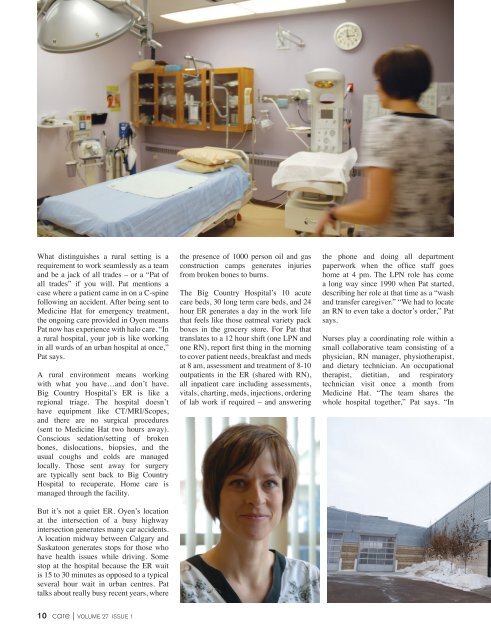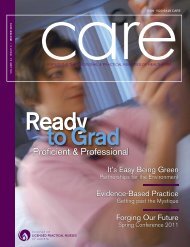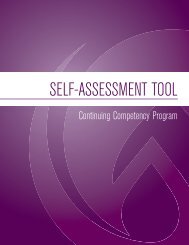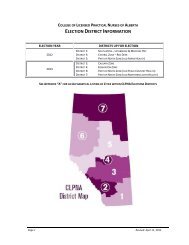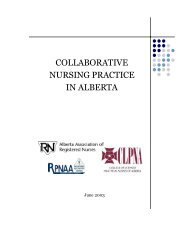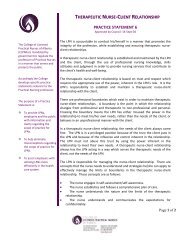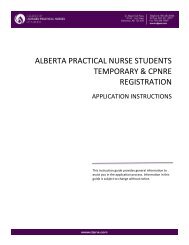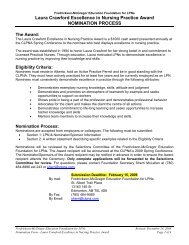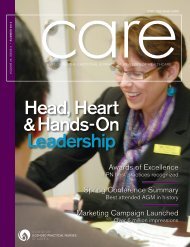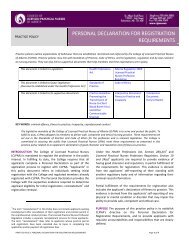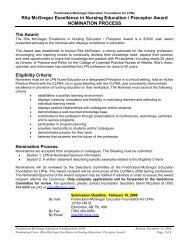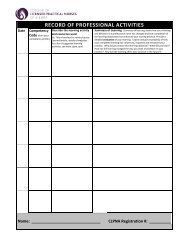What distinguishes a rural setting is arequirement to work seamlessly as a teamand be a jack <strong>of</strong> all trades – or a “Pat <strong>of</strong>all trades” if you will. Pat mentions acase where a patient came in on a C-spinefollowing an accident. After being sent toMedicine Hat for emergency treatment,the ongoing care provided in Oyen meansPat now has experience with halo care. “Ina rural hospital, your job is like workingin all wards <strong>of</strong> an urban hospital at once,”Pat says.A rural environment means workingwith what you have…and don’t have.Big Country Hospital’s ER is like aregional triage. The hospital doesn’thave equipment like CT/MRI/Scopes,and there are no surgical procedures(sent to Medicine Hat two hours away).Conscious sedation/setting <strong>of</strong> brokenbones, dislocations, biopsies, and theusual coughs and colds are managedlocally. Those sent away for surgeryare typically sent back to Big CountryHospital to recuperate. Home care ismanaged through the facility.But it’s not a quiet ER. Oyen’s locationat the intersection <strong>of</strong> a busy highwayintersection generates many car accidents.A location midway between Calgary andSaskatoon generates stops for those whohave health issues while driving. Somestop at the hospital because the ER waitis 15 to 30 minutes as opposed to a typicalseveral hour wait in urban centres. Pattalks about really busy recent years, wherethe presence <strong>of</strong> 1000 person oil and gasconstruction camps generates injuriesfrom broken bones to burns.The Big Country Hospital’s 10 acutecare beds, 30 long term care beds, and 24hour ER generates a day in the work lifethat feels like those oatmeal variety packboxes in the grocery store. For Pat thattranslates to a 12 hour shift (one LPN andone RN), report first thing in the morningto cover patient needs, breakfast and medsat 8 am, assessment and treatment <strong>of</strong> 8-10outpatients in the ER (shared with RN),all inpatient care including assessments,vitals, charting, meds, injections, ordering<strong>of</strong> lab work if required – and answeringthe phone and doing all departmentpaperwork when the <strong>of</strong>fice staff goeshome at 4 pm. The LPN role has comea long way since 1990 when Pat started,describing her role at that time as a “washand transfer caregiver.” “We had to locatean RN to even take a doctor’s order,” Patsays.<strong>Nurses</strong> play a coordinating role within asmall collaborative team consisting <strong>of</strong> aphysician, RN manager, physiotherapist,and dietary technician. An occupationaltherapist, dietitian, and respiratorytechnician visit once a month fromMedicine Hat. “The team shares thewhole hospital together,” Pat says. “In10 care | volume 27 issue 1
ural environments there’s no one else todo things, and the team has to be strongbecause anything can come throughthe front door.” The fabric <strong>of</strong> workingrelationships is tight knit. Pat has workedwith the same RN for many years, andshe describes their working relationshipas “a left hand for the right hand and viceversa.”The physician in a small town is valued asgold, as evidenced by loss <strong>of</strong> the obstetricsfunction from the hospital when a seconddoctor in Oyen moved away from thecommunity. To the rest <strong>of</strong> the team thatmeans taking on as much responsibilityas possible to lighten the doctor’s loadduring his early morning presence at thehospital and otherwise avoid burnout.One thing that feels more rooted in ruralhealthcare is the human relationship. It’sbeen said that people in small towns,much more than cities, share a destiny.With a resident population <strong>of</strong> 1000 and along history <strong>of</strong> pioneering values whereword is honour, looking one in the eyeis measure <strong>of</strong> honesty and integrity,reputation is everything, and loyalty isgenerational - relationship lies at the soul<strong>of</strong> community life.Given nursing is a heartfelt pr<strong>of</strong>ession,community bonds have a number <strong>of</strong>pr<strong>of</strong>ound implications in a rural setting.“You treat the person you know on afirst name basis (even family members)and then see them downtown or at thepost <strong>of</strong>fice,” Pat says. “People see howyou helped them as a big deal. Trust isimmediate…because it’s been earned byhow people know you in the community,and what you do at the hospital is respectedas core to the fabric <strong>of</strong> community.” Onthe other side <strong>of</strong> the coin, there is noanonymity and you can’t take work hometo your spouse. As Pat says, “Your spousewill know the 70 year old who broke theirarm.”Given nursingis a heartfeltpr<strong>of</strong>ession,community bondshave a number<strong>of</strong> pr<strong>of</strong>oundimplications ina rural setting.Feedback feels more direct and immediate,and appreciation more enduring in a ruralsetting, Pat notes. “Just the other day, aMom I ran into said she had been thinkingabout the day her child was injured…howshe remembered I had climbed on the bedand held her arm to X-ray. She wanted meto know she was glad I was there.”Rural healthcare delivery has a uniqueform <strong>of</strong> patient perspective. “An averagestay might be a little longer than an urbanhospital,” Pat says. “You <strong>of</strong>ten knowwhether they have supports at home ornot or whether they can personally cope.And so sometimes you make a decision todelay a return home just a little, becausethe health <strong>of</strong> the total person in a completecontext is more known.”Emotionally, death touches closer tohome. “Chances are you know a patientoutside the hospital,” Pat says. “You makesure a person doesn’t die alone. You go toevery funeral.”Emotionally, there are also momentselevated by seeing life through the eyes <strong>of</strong>the well-experienced. “I sit by the bed <strong>of</strong>elderly people and they share stories,” Patsays. “They talk about life so different thanours….simpler and more connected…without all the electronic gadgetry thatconfuses our lives….the stories <strong>of</strong> warbrides can be heart wrenching….a womanwho lived in a concentration camptroubled to talk about it even all theseyears later…stories like one would readabout in a book.”That the wise ultimately gauge successfullife by the value <strong>of</strong> friends and familysays something about rural healthcare.Here, there’s time to listen to stories,and “patient” takes on deeper meaninggrounded in small town values. Everyonewants to be heard, with humanity, tohelp bridge over fear <strong>of</strong> being scared andfaceless when most vulnerable.>care | spring 2013 11


